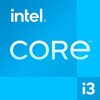Qualcomm Snapdragon X Plus X1P-64-100 vs Intel Core i3-1220P vs Qualcomm Snapdragon X Elite X1E-78-100
Qualcomm Snapdragon X Plus X1P-64-100
► remove from comparison
The Snapdragon X Plus X1P-64-100 is a moderately fast ARM architecture processor (SoC) for use in Windows laptops that debuted in April 2024. The X1P-64-100 has 10 Oryon CPU cores (10 threads) running at no more than 3.4 GHz. Other key features include the 3.8 TFLOPS Adreno X1-85 GPU, the 45 TOPS Hexagon NPU and an impressively fast LPDDR5x-8448 memory controller.
The chip's smarter X Elite series brothers including first and foremost the Snapdragon X Elite X1E-84-100 are thought to be based on the same die with the same NPU but with more CPU cores enabled, higher GPU clock speeds, higher CPU clock speeds and possibly higher power targets as well.
Architecture and Features
Qualcomm Oryon cores are in part based on Nuvia IP; they most likely make use of the ARM v8.7 microarchitecture. Much like modern AMD and Intel processors, the Snapdragon chip is compatible with USB 4 and thus with Thunderbolt 4 but it remains to be seen if it is is compatible with GeForce or Radeon discrete graphics cards.
The Qualcomm SoC is said to have 12 PCIe 4 and 4 PCIe 3 lanes for connecting various kinds of devices. NVMe SSDs are supported with a throughput of up to 7.9 GB/s; furthermore, most laptops built around the chip are expected to have 16 GB of LPDDR5X-8448 RAM. There is also a 45 TOPS NPU for accelerating AI workloads.
Performance
Its multi-thread performance is very close to that of the Intel Core i7-13700H and the 9-core Apple M4, meaning this is a pretty fast CPU that's good for most tasks one could possibly throw at it in 2024.
Like any other Windows on ARM platform, the Snapdragon X chip works best with applications and games compiled specifically for ARM processors. If making use of the built-in x86 to ARM emulation mode, a performance penalty of about 20% is to be expected.
Graphics
The 3.8 TFLOPS Adreno X1-85 iGPU is DirectX 12-enabled but not DirectX 12 Ultimate-enabled, despite featuring VRS and ray tracing support. The 3.8 TFLOPS of performance that it supposedly delivers pale in comparison to the slowest current-generation professional Nvidia Ada graphics card for laptops, the RTX 500 Ada, that delivers up to 9.2 TFLOPS.
Its gaming performance is rather underwhelming; while slightly faster than the aging Iris Xe (96 EUs), the Adreno is not fast enough to outpace the Radeon 780M meaning there is little point in comparing it with full-fat discrete graphics cards. Baldur's Gate 3, a triple-A title released in 2023, is pretty much unplayable at 1080p / Low. GTA V, a game that saw the light of day in 2015, is playable at 1080p / High.
The Qualcomm iGPU will let you use up to 3 UHD 2160p monitors simultaneously. 2160p120 integrated displays are supported, as are the popular AV1, HEVC and AVC video codecs (both decoding and encoding). The hardware does not support the VVC codec; that feature remains a Lunar Lake exclusive for now.
Power consumption
The X1P-64-100 is most likely going to be less power-hungry than its more powerful X Elite brothers. Expect to see anything between 10 W and 35 W under long-term workloads because that's what Ryzen U chips normally consume.
The SoC is built with a 4 nm TSMC process for decent, as of H1 2024, energy efficiency.
Intel Core i3-1220P
► remove from comparison
The Intel Core i3-1220P is a lower mid-range Alder Lake family SoC designed for use in ultra-light, ultra-thin laptops of the more affordable flavour. It was announced in early 2022 and it has 2 performance cores as opposed to the 6 cores of the top-of-the-line i7-1280P (P-cores, Golden Cove architecture) mated to 8 efficient cores (E-cores, Gracemont architecture). The i3's P-cores are Hyper-Threading-enabled for a total of 12 threads when combined with its E-cores. The clock speeds range from 1.5 GHz to 4.4 GHz for the performance cluster and 1.1 GHz to 3.3 GHz for the efficient cluster. The shortcomings of this processor as compared with the faster Core i5-1240P are many, including the significantly slower iGPU, lower CPU core count, lower clock speeds, complete lack of the vPro features.
Architecture
The i3 is a continuation of Intel's efforts to use the ARM-developed big.LITTLE technology for its own benefit. A single "little" Alder Lake core is supposed to be as fast as a Skylake core (as found in the venerable Core i7-6700HQ among other options) which is six years old at this point. All of Core i3-1220P's CPU cores enjoy access to 12 MB of L3 cache. The integrated memory controller supports various memory types up to LPDDR5-5200, DDR5-4800, LPDDR4x-4267 or DDR4-3200; Intel suggests using no more than 64 GB of RAM, for reference. Just like the other 12th Gen Intel Core processors, this Core i3 comes with the Thread Director which is a new functionality designed to help Windows 11 decide which cores to use for what workload for best performance and efficiency possible. Hardware acceleration of AI algorithms is supported via GNA 3.0 and DL Boost (via AVX2). PCI-Express 5.0 support has not found its way into Alder Lake P processors, so users will have to be content with PCI-Express 4.0 for the time being. Four PCI-Express 4 lanes allow for a read/write rate of up to 7.9 GB/s, provided a suitably fast NVMe SSD is used.
Please note that this is not a user-replaceable CPU. It gets soldered permanently on to the motherboard (FCBGA1744 socket interface).
Performance
While we have not tested a single system built around the 1220P as of October 2023, we have tested a laptop featuring the i5-1240U, a chip with nearly the same specs (2 P-cores mated to 8 E-cores, all running at the same clock speeds as what the 1220P has). Based on that, we expect the 1220P to be just slightly ahead of the Core i5-11400H, the Core i7-1265U and also the Ryzen 5 5600U, as far as multi-thread benchmark scores are concerned. Your mileage may vary depending on how high the CPU power limits are and how competent the cooling solution of your system is.
Graphics
The built-in graphics adapter in the form of the 64 EU UHD Graphics running at up to 1.1 GHz is a slightly downgraded 80 EU Iris Xe. The latter can be found in many Alder Lake-P and Tiger Lake-UP3 processors, like a Core i5-1250P or a Core i5-1145G7, respectively. Despite the lower EU cluster count, this is still a fairly capable iGPU, loaded with modern features such as the AV1 video decoding capability and SUHD 4320p monitor support. The UHD Graphics will happily drive up to 4 monitors simultaneously, provided the laptop has the outputs required. Its gaming performance is unlikely to please the crowds, though, as it will be good for resolutions no higher than 1600x900 and Low settings only in most titles trleased in 2021 and 2022. Your mileage may vary depending on how high the Power Limits are and how capable the cooling solution of a laptop is. Fast RAM is a prerequisite for decent performance as well (the UHD Graphics has to make do with no dedicated video memory).
Power consumption
The i3's base power consumption (also known as the default TDP or Power Limit 1) is 28 W; its "minimum assured" power consumption sits at 20 W. In the meantime, the maximum Turbo power consumption (also known as the PL2) is not supposed to exceed 64 W.
This 12th generation Intel chip is built with Intel's fourth-gen 10 nm process marketed as Intel 7 for decent, as of late 2022, energy efficiency. Expect the i3 to be significantly less power-hungry (and a lot easier to cool) than all other Alder Lake-P chips because of its lower core count.
Qualcomm Snapdragon X Elite X1E-78-100
► remove from comparison
The Snapdragon X Elite X1E-78-100 is a pretty fast ARM architecture processor (SoC) for use in Windows laptops. The X1E-78-100 is the least powerful member of the Snapdragon X Elite processor series, as of May 2024; as such, it has 12 Oryon CPU cores (3 clusters of equally powerful cores; 12 threads) running at no more than 3.4 GHz. Other key features include the 3.8 TFLOPS Adreno X1-85 iGPU, the 45 TOPS Hexagon NPU and an impressively fast LPDDR5x-8448 memory controller.
The top dog, known as the Snapdragon X Elite X1E-84-100, is thought to be based on the same die with the same NPU but with higher GPU clock speeds, higher CPU clock speeds and possibly higher power targets as well.
Architecture and Features
Qualcomm Oryon cores are in part based on Nuvia IP; they most likely make use of the ARM v8.7 microarchitecture. Much like modern AMD and Intel processors, the Snapdragon chip is compatible with USB 4 and thus with Thunderbolt 4 but it remains to be seen if the X Elite is compatible with GeForce or Radeon discrete graphics cards.
The SoC is said to have 12 PCIe 4 and 4 PCIe 3 lanes for connecting various kinds of devices. NVMe SSDs are supported with a throughput of up to 7.9 GB/s; furthermore, most laptops built around the chip are expected to have 16 GB of LPDDR5X-8448 RAM. There is also a 45 TOPS NPU for accelerating AI workloads.
Performance
Our first benchmarks (featuring a 35 W X Elite X1E-78-100) revealed very decent CPU performance figures that see the X Elite going head-to-head with the AMD Ryzen 7 7840U. It's also not much faster or slower than the Apple M3 chip with 10 GPU cores. While not groundbreaking, this should be good enough for the user to be able to run any applications in 2024 and 2025.
Like any other Windows on ARM platform, the Snapdragon X chip works best with applications and games compiled specifically for ARM processors. If making use of the built-in x86 to ARM emulation mode, a performance penalty of about 20% is to be expected.
Graphics
The integrated 3.8 TFLOPS Adreno X1-85 GPU is DirectX 12-enabled but not DirectX 12 Ultimate-enabled, despite featuring VRS and ray tracing support. The 3.8 TFLOPS of performance that it supposedly delivers pale in comparison to the slowest current-generation professional Nvidia Ada graphics card for laptops, the RTX 500 Ada, that's good for up to 9.2 TFLOPS.
Its gaming performance is rather underwhelming according to our in-house testing results. While slightly faster than the aging Iris Xe (96 EUs), the Adreno fails to outgun the Radeon 780M meaning there is little point in comparing it with full-fat discrete graphics cards. Baldur's Gate 3, a triple-A title released in 2023, is pretty much unplayable at 1080p / Low. GTA V, a game that saw the light of day in 2015, is playable at 1080p / High.
The Qualcomm iGPU will let you use up to 3 UHD 2160p monitors simultaneously. 2160p120 integrated displays are supported, as are the popular AV1, HEVC and AVC video codecs (both decoding and encoding). The hardware does not support the VVC codec; that feature remains a Lunar Lake exclusive for now.
Power consumption
The X1E-78-100 is set to be slightly less power-hungry than its more powerful brothers. Expect to see anything between 20 W and 45 W under long-term workloads depending on the system and on the performance profile chosen. That's exactly what Ryzen HS chips normally consume.
The SoC is built with a 4 nm TSMC process for decent, as of H1 2024, energy efficiency.
| Model | Qualcomm Snapdragon X Plus X1P-64-100 | Intel Core i3-1220P | Qualcomm Snapdragon X Elite X1E-78-100 | ||||||||||||||||||||||||||||||||||||||||||||||||||||||||||||||||||||||||||||||||||||||||
| Codename | Oryon | Alder Lake-P | Oryon | ||||||||||||||||||||||||||||||||||||||||||||||||||||||||||||||||||||||||||||||||||||||||
| Series | Qualcomm Snapdragon X | Intel Alder Lake-P | Qualcomm Snapdragon X | ||||||||||||||||||||||||||||||||||||||||||||||||||||||||||||||||||||||||||||||||||||||||
| Series: Snapdragon X Oryon |
|
|
| ||||||||||||||||||||||||||||||||||||||||||||||||||||||||||||||||||||||||||||||||||||||||
| Clock | <=3400 MHz | 1100 - 4400 MHz | <=3400 MHz | ||||||||||||||||||||||||||||||||||||||||||||||||||||||||||||||||||||||||||||||||||||||||
| L1 Cache | 2.3 MB | 928 KB | 2.3 MB | ||||||||||||||||||||||||||||||||||||||||||||||||||||||||||||||||||||||||||||||||||||||||
| L2 Cache | 12 MB | 9.5 MB | 12 MB | ||||||||||||||||||||||||||||||||||||||||||||||||||||||||||||||||||||||||||||||||||||||||
| L3 Cache | 6 MB | 12 MB | 6 MB | ||||||||||||||||||||||||||||||||||||||||||||||||||||||||||||||||||||||||||||||||||||||||
| Cores / Threads | 10 / 10 10 x 3.4 GHz Qualcomm Oryon | 10 / 12 | 12 / 12 8 x 3.4 GHz 4 x 3.4 GHz Qualcomm Oryon | ||||||||||||||||||||||||||||||||||||||||||||||||||||||||||||||||||||||||||||||||||||||||
| Technology | 4 nm | 10 nm | 4 nm | ||||||||||||||||||||||||||||||||||||||||||||||||||||||||||||||||||||||||||||||||||||||||
| iGPU | Qualcomm SD X Adreno X1-85 3.8 TFLOPS | Intel UHD Graphics 64EUs (Alder Lake 12th Gen) ( - 1100 MHz) | Qualcomm SD X Adreno X1-85 3.8 TFLOPS | ||||||||||||||||||||||||||||||||||||||||||||||||||||||||||||||||||||||||||||||||||||||||
| Architecture | ARM | x86 | ARM | ||||||||||||||||||||||||||||||||||||||||||||||||||||||||||||||||||||||||||||||||||||||||
| Announced | |||||||||||||||||||||||||||||||||||||||||||||||||||||||||||||||||||||||||||||||||||||||||||
| Manufacturer | www.qualcomm.com | ark.intel.com | www.qualcomm.com | ||||||||||||||||||||||||||||||||||||||||||||||||||||||||||||||||||||||||||||||||||||||||
| TDP | 28 Watt | 35 Watt | |||||||||||||||||||||||||||||||||||||||||||||||||||||||||||||||||||||||||||||||||||||||||
| max. Temp. | 100 °C | ||||||||||||||||||||||||||||||||||||||||||||||||||||||||||||||||||||||||||||||||||||||||||
| Socket | BGA1744 | ||||||||||||||||||||||||||||||||||||||||||||||||||||||||||||||||||||||||||||||||||||||||||
| Features | DDR4-3200/LPDDR4x-4266/DDR5-4800/LPDDR5-5200 RAM, PCIe 4, Thread Director, DL Boost, GNA, MMX, SSE, SSE2, SSE3, SSSE3, SSE4.1, SSE4.2, AVX, AVX2, BMI2, ABM, FMA, ADX, SMEP, SMAP, EIST, TM1, TM2, Hyper-Threading, Turbo, SST, AES-NI, RDRAND, RDSEED, SHA | ||||||||||||||||||||||||||||||||||||||||||||||||||||||||||||||||||||||||||||||||||||||||||
| TDP Turbo PL2 | 45 Watt |
Benchmarks
Average Benchmarks Qualcomm Snapdragon X Plus X1P-64-100 → 100% n=2
Average Benchmarks Intel Core i3-1220P → 71% n=2
Average Benchmarks Qualcomm Snapdragon X Elite X1E-78-100 → 104% n=2
* Smaller numbers mean a higher performance
1 This benchmark is not used for the average calculation













